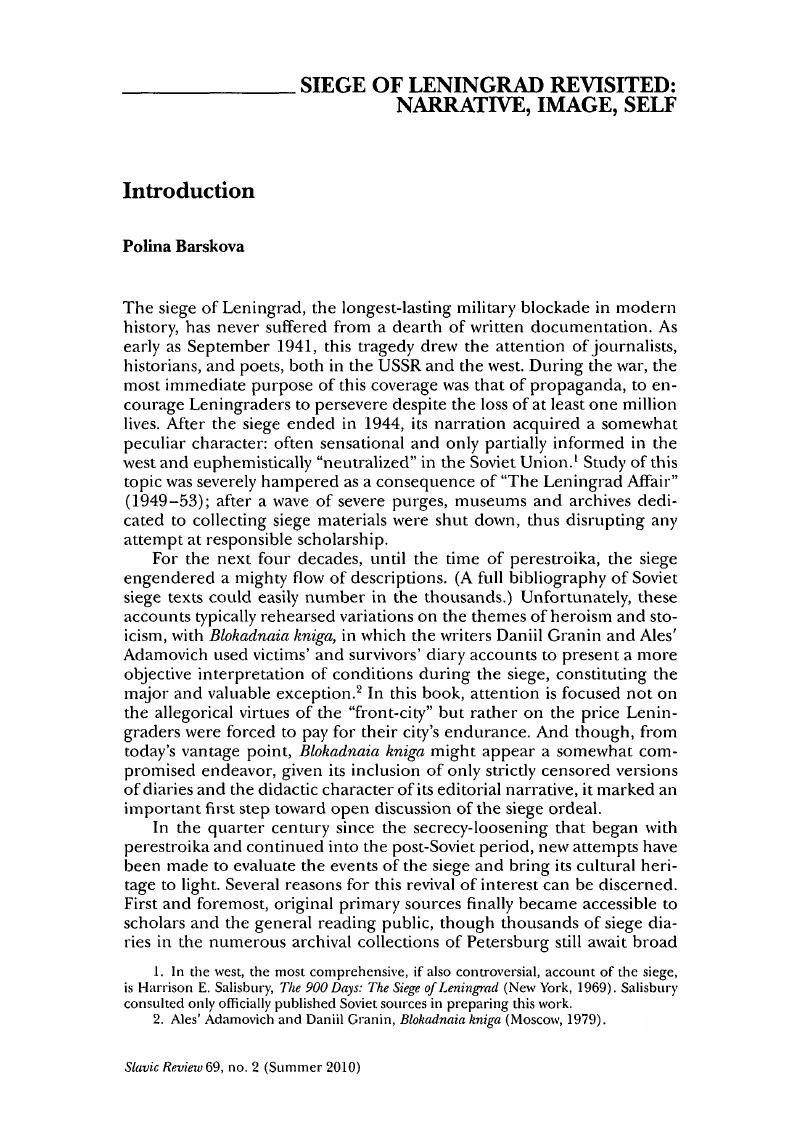No CrossRef data available.

1. In the west, the most comprehensive, if also controversial, account of the siege, is Harrison E. Salisbury, The 900 Days: The Siege of Leningrad (New York, 1969). Salisbury consulted only officially published Soviet sources in preparing this work.
2. Ales’ Adamovich and Daniil Granin, Blokadnaia kniga (Moscow, 1979).
3. The most interesting recent publications of siege diaries include V. Koval'chuk, ed., Chelovek v blokade: Novye svidetel'stva (St. Petersburg, 2008) and V. Koval'chuk, ed., Dozhivem li my do tishiny: Zapiski iz blokadnogo Leningrada (St. Petersburg, 2009), as well as the periodic publications of siege materials in Trudy Gosudarstvennogo muzeia istorii Sankt-Peterburga.
4. Cynthia Simmons and Nina Perlina, eds., Writing the Siege of Leningrad: Women's Diaries, Memoirs, and Documentary Prose (Pittsburgh, 2002).
5. Among Nikita A. Lomagin's publications, I would highlight Neizvestnaia blokada (St. Petersburg, 2002).
6. Van Buskirk is coeditor, with Andrei Zorin, of the forthcoming edition of Ginzburg's siege-era prose: Prokhodiashchie kharaktery (Zapiski blokadnogo cheloveka. Proza voennykh let) (Moscow, forthcoming).
7. M. V. Loskutova, ed., Pamiat’ o blokade: Svidetel'stva ochevidtsev i istoricheskoe soznanie obshchestva. Materialy i issledovaniia (Moscow, 2006).
8. Lisa A. Kirschenbaum, The Legacy of the Siege of Leningrad, 1941–1995: Myth, Memories, and Monuments (Cambridge, Eng., 2006).
9. Lidiya Ginzburg, Blockade Diary, trans. Alan Myers (London, 1995), 27.
10. Sofiia Ostrovskaia, “Blokadnye dnevniki,” Russkoeproshloe, 2006, no. 10: 310.
11. Druskin, Iakov , Dnevniki (St. Petersburg, 1999), 117.Google Scholar
12. The allusion is to the seminal work on the art of the Holocaust: Ziva Amishai- Maisels, Depiction and Interpretation: The Influence of the Holocaust on the Visual Arts (Oxford, 1993). Her argument distinguishes between the two vectors of historical trauma compensation available through artistic expression: immediate depiction and consequent interpretation.
13. Though the present cluster concentrates on logocentric approaches to the siege, I would also emphasize the importance of the recent siege research conducted by our colleagues in related areas of study, for example, historians Richard Bidlack, Steven Maddox, and Alexis Peri and sociologist Jeffrey Kenneth Hass.